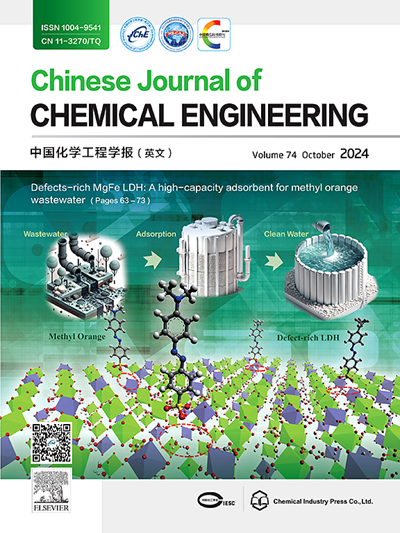旋转填充床共沉淀法合成聚合Janus纳米颗粒以稳定香芹醇包封的皮克林乳液
IF 3.7
3区 工程技术
Q2 ENGINEERING, CHEMICAL
引用次数: 0
摘要
由于其不稳定性和不溶于水性,香芹酚在食品和生物农药等不同领域的实际应用受到了限制。本研究以聚合Janus纳米颗粒为稳定剂,制备了香芹醇包封皮克林乳液。为了实现这一目标,首先在旋转填充床反应器中通过共沉淀法制备了由紫胶和聚乳酸(PLA)组成的哑铃状聚合物纳米颗粒,然后将壳寡糖(COS)接枝到紫胶上合成两亲性Janus纳米颗粒(PLA/紫胶-COS)。通过配置不同油水比的香芹酚乳剂,制备出具有典型水包油、双连续结构和油包水特征的Pickering乳剂。用0.5% PLA/虫胶- cos纳米粒子稳定5%香芹酚含量的乳液的稳定性比用虫胶纳米粒子和PLA/虫胶纳米粒子制备的乳液更稳定。保存一个月后,香芹酚包封的Pickering乳剂保持了−43.8 mV的高zeta电位,粒径没有明显变化。这些初步研究表明,在旋转填充床中共沉淀法合成的聚合Janus纳米颗粒是未来Pickering乳剂和相关工作的理想颗粒。本文章由计算机程序翻译,如有差异,请以英文原文为准。

Synthesis of polymeric Janus nanoparticles by co-precipitation in a rotating packed bed to stabilize carvacrol encapsulated Pickering emulsions
Practical application of carvacrol in different fields including foods and biopesticides has been limited due to its instability and water insolubility. In this work, carvacrol encapsulated Pickering emulsion is developed by using polymeric Janus nanoparticles as the stabilizer. To achieve this, dumbbell-shaped polymeric nanoparticles composed of two spheres of shellac and polylactic acid (PLA) are firstly prepared via co-precipitation in a rotating packed bed reactor, followed by grafting of chitooligosaccharides (COS) onto shellac to synthesis amphiphilic Janus nanoparticles (PLA/shellac-COS). Pickering emulsions with typical oil-in-water, bi-continuous structure and water-in-oil characteristics are produced by configuring carvacrol emulsions with different oil-to-water ratios. The stability of emulsions with 5% carvacrol content stabilized by 0.5% PLA/shellac-COS nanoparticles were more stable when compared to those prepared by shellac nanoparticles and PLA/shellac nanoparticles. After stored for one month, the carvacrol encapsulated Pickering emulsions maintained a high zeta potential of −43.8 mV, with no significant changes in particle size. These preliminary studies illustrated that polymeric Janus nanoparticles synthesized by co-precipitation in a rotating packed bed are promising particles for Pickering emulsions and related work in the future.
求助全文
通过发布文献求助,成功后即可免费获取论文全文。
去求助
来源期刊

Chinese Journal of Chemical Engineering
工程技术-工程:化工
CiteScore
6.60
自引率
5.30%
发文量
4309
审稿时长
31 days
期刊介绍:
The Chinese Journal of Chemical Engineering (Monthly, started in 1982) is the official journal of the Chemical Industry and Engineering Society of China and published by the Chemical Industry Press Co. Ltd. The aim of the journal is to develop the international exchange of scientific and technical information in the field of chemical engineering. It publishes original research papers that cover the major advancements and achievements in chemical engineering in China as well as some articles from overseas contributors.
The topics of journal include chemical engineering, chemical technology, biochemical engineering, energy and environmental engineering and other relevant fields. Papers are published on the basis of their relevance to theoretical research, practical application or potential uses in the industry as Research Papers, Communications, Reviews and Perspectives. Prominent domestic and overseas chemical experts and scholars have been invited to form an International Advisory Board and the Editorial Committee. It enjoys recognition among Chinese academia and industry as a reliable source of information of what is going on in chemical engineering research, both domestic and abroad.
 求助内容:
求助内容: 应助结果提醒方式:
应助结果提醒方式:


